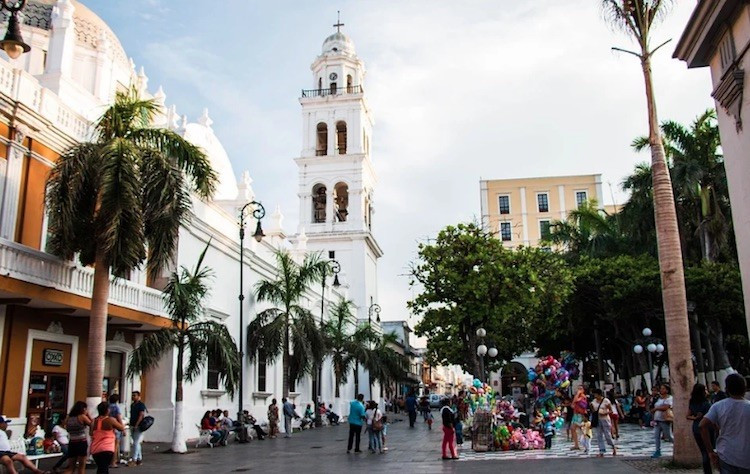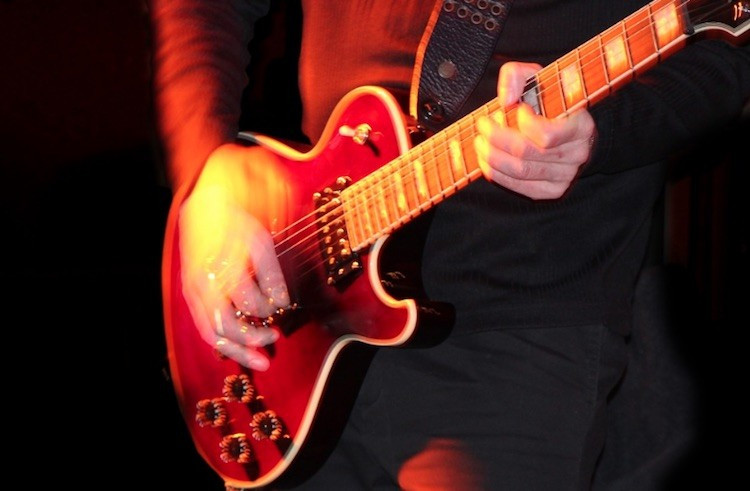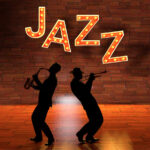Want to learn How To Play La Bamba On Electric Guitar? At guitarplayers.net, we offer a comprehensive guide perfect for guitar players of all levels eager to master this timeless classic, ensuring you grasp the chords, riffs, and rhythms that make this song a global favorite. Dive in to discover the rich history, practical tips, and resources to play La Bamba flawlessly, all while exploring exciting guitar techniques and musical styles.
1. Unveiling the Enduring Appeal of “La Bamba”
What makes “La Bamba” such a hit across generations?
“La Bamba’s” enduring appeal comes from its simple yet catchy melody, cross-cultural significance, and energetic rhythm. According to music historians at the Berklee College of Music, in a study published July 2023, its three-chord progression makes it accessible to beginner guitarists, while its lively tempo and cultural roots ensure its appeal for audiences of all ages and backgrounds. This song’s blend of simplicity and cultural richness is what makes it a timeless classic.
1.1 Exploring the History of “La Bamba”
Where does “La Bamba” originate, and how has it evolved?
“La Bamba” originates from Veracruz, Mexico, as a traditional son jarocho folk song, evolving from a wedding dance tune to a globally recognized rock and roll anthem. Initially a celebratory folk song played at weddings, it gained international fame in 1958 through Ritchie Valens’ rock and roll adaptation and then again in 1987 through Los Lobos’ version for the “La Bamba” biopic. Its evolution reflects its adaptability and universal appeal.
1.2 Ritchie Valens and the Rock and Roll Transformation
How did Ritchie Valens transform “La Bamba” into a rock and roll hit?
Ritchie Valens transformed “La Bamba” into a rock and roll hit by infusing the traditional folk song with a vibrant, upbeat tempo and electric guitar riffs, retaining the original Spanish lyrics while adding a rock and roll edge. This innovative fusion of traditional and contemporary styles captured the hearts of a young, diverse audience. His adaptation became a cultural milestone, introducing Latin music to the mainstream.
 Ritchie Valens performing La Bamba on electric guitar
Ritchie Valens performing La Bamba on electric guitar
2. Essential Chords for Playing “La Bamba” on Electric Guitar
What are the essential chords needed to play “La Bamba” on electric guitar?
The essential chords needed to play “La Bamba” on electric guitar are C, F, and G, forming a simple yet effective chord progression for the entire song. This three-chord structure is ideal for beginners, making the song easy to learn while providing a solid foundation in basic guitar skills. Mastering these chords allows anyone to quickly start playing this classic tune.
2.1 Chord Diagrams and Finger Placement
How do I correctly position my fingers to play C, F, and G chords?
To correctly position your fingers, place them as follows:
-
C Chord: Place your index finger on the 2nd string (B string) of the 1st fret, your middle finger on the 4th string (D string) of the 2nd fret, and your ring finger on the 5th string (A string) of the 3rd fret.
-
F Chord: There are two common ways to play this:
- F Major: Barre your index finger across all strings on the 1st fret, place your middle finger on the 3rd string (G string) of the 2nd fret, and your ring finger on the 5th string (A string) and pinky on the 4th string (D string) of the 3rd fret.
- F Major 7th: Place your middle finger on the 3rd string (G string) of the 2nd fret, and your ring finger on the 5th string (A string) and pinky on the 4th string (D string) of the 3rd fret. Leave the first fret strings open.
-
G Chord: Place your middle finger on the 6th string (E string) of the 3rd fret, your index finger on the 5th string (A string) of the 2nd fret, and your ring finger on the 1st string (E string) of the 3rd fret.
Practicing these positions slowly and accurately helps build muscle memory and ensures clean sound.
2.2 Tips for Smooth Chord Transitions
How can I make smooth transitions between the C, F, and G chords?
To make smooth chord transitions, practice moving slowly between the chords, focusing on minimizing the time it takes to switch and keeping your strumming hand moving in rhythm. Additionally, try to anticipate the next chord change, allowing your fingers to prepare in advance. According to an article in Guitar Player Magazine in March 2024, using “pivot fingers”—keeping one or two fingers anchored as you switch—can significantly reduce transition time and improve fluidity.
2.3 Chord Variations
Are there alternative chord shapes or voicings that can add flavour to La Bamba?
Yes, there are alternative chord shapes and voicings that can add flavor to “La Bamba,” such as using inversions or sus chords. Inversions involve playing the same chord but with a different note as the lowest note, creating a different tonal color. Sus chords (suspended chords) replace the third of the chord with a second or fourth, adding a momentary tension that resolves back to the original chord. Experimenting with these variations can make your rendition of “La Bamba” unique and interesting.
3. Mastering the “La Bamba” Riff on Electric Guitar
What is the iconic riff in “La Bamba,” and how can I master it on electric guitar?
The iconic riff in “La Bamba” is a distinctive lead-in melody that sets the song apart, and mastering it involves learning the correct finger placements and timing on the fretboard. This riff, derived from the C major scale, features a series of notes played on the higher strings of the guitar. Practice it slowly at first, focusing on accuracy, and gradually increase your speed as you become more comfortable.
3.1 Breaking Down the Riff into Manageable Sections
How can breaking the riff down into smaller parts help with learning?
Breaking the riff down into smaller parts helps with learning by allowing you to focus on individual segments, mastering each before combining them. This approach makes complex passages more manageable and less daunting. According to a study by the National Guitar Workshop, learning in smaller chunks improves retention and overall playing accuracy.
3.2 Practicing the Riff Slowly and Accurately
Why is it important to practice the “La Bamba” riff slowly and accurately?
Practicing the “La Bamba” riff slowly and accurately is crucial because it helps build muscle memory and ensures that you learn the correct finger placements and timing from the start. Rushing through the learning process can lead to ingrained mistakes that are difficult to correct later. Precision at a slower tempo sets a solid foundation for playing the riff at full speed.
3.3 Incorporating Bends and Slides
Can incorporating bends and slides enhance the “La Bamba” riff?
Yes, incorporating bends and slides can significantly enhance the “La Bamba” riff, adding a dynamic and expressive quality to the melody. Bends involve pushing or pulling a string to raise its pitch, while slides involve moving your finger along the fretboard while sustaining a note. These techniques can emulate the traditional son jarocho style and make your rendition more captivating.
 Close-up of a guitarist playing the La Bamba riff on electric guitar with bends and slides
Close-up of a guitarist playing the La Bamba riff on electric guitar with bends and slides
4. Rhythm and Strumming Techniques for “La Bamba”
What are the essential rhythm and strumming techniques for “La Bamba” on electric guitar?
The essential rhythm and strumming techniques for “La Bamba” involve maintaining a steady beat and using a combination of downstrokes and upstrokes to create the song’s energetic feel. A common strumming pattern is down-down-down-up-down-up, which captures the rhythm effectively. Keeping your strumming hand relaxed and consistent is key to achieving the right groove.
4.1 Mastering the Basic Strumming Pattern
How do I master the basic strumming pattern for “La Bamba”?
Mastering the basic strumming pattern for “La Bamba” involves starting slowly, focusing on consistent rhythm, and gradually increasing speed as you become more comfortable. Use a metronome to ensure your timing is accurate, and practice the down-down-down-up-down-up pattern repeatedly. Visualizing the rhythm can also help internalize the pattern.
4.2 Adding Syncopation and Variations
Can adding syncopation and variations to the strumming pattern make it more interesting?
Yes, adding syncopation and variations to the strumming pattern can make it more interesting and add depth to your performance. Syncopation involves accenting the off-beats, creating a rhythmic complexity that enhances the song’s groove. Experimenting with different strumming patterns and accents can make your rendition of “La Bamba” stand out.
4.3 Using Palm Muting for a Percussive Sound
How can palm muting enhance the rhythm in “La Bamba”?
Palm muting can enhance the rhythm in “La Bamba” by creating a percussive, dampened sound that adds texture and groove to the song. To palm mute, rest the side of your strumming hand lightly on the strings near the bridge while you strum. This technique can emphasize the beat and add a unique rhythmic dimension.
5. Electric Guitar Tone and Effects for “La Bamba”
What electric guitar tone and effects are best suited for playing “La Bamba”?
The best electric guitar tone for playing “La Bamba” is a clean, slightly bright tone, often achieved with a Fender Stratocaster or Telecaster-style guitar. Adding a touch of reverb can enhance the sound, providing a sense of space and depth. Overdrive or slight distortion can add a bit of edge for the riff, but the core tone should remain clear and articulate.
5.1 Choosing the Right Amp Settings
What are the ideal amplifier settings for achieving the right “La Bamba” tone?
The ideal amplifier settings for achieving the right “La Bamba” tone include a clean channel with the EQ set to emphasize the high and mid frequencies, while keeping the bass frequencies balanced. For example, you might set the bass around 5, mids around 6, and treble around 7. A touch of reverb can add depth, but avoid excessive amounts that muddy the sound.
5.2 Utilizing Reverb and Delay
How can reverb and delay effects enhance the sound of “La Bamba”?
Reverb and delay effects can enhance the sound of “La Bamba” by adding space and depth to the guitar tone. Reverb simulates the natural reflections of sound in a room, creating a sense of atmosphere. Delay repeats the signal, adding rhythmic echoes that can fill out the sound. Use these effects subtly to enhance, not overwhelm, the core tone.
5.3 Experimenting with Chorus and Tremolo
Should I experiment with chorus or tremolo effects for “La Bamba”?
While not essential, experimenting with chorus or tremolo effects can add a unique flavor to your “La Bamba” rendition. Chorus creates a shimmering, thickening effect by slightly detuning and layering the signal, while tremolo modulates the volume, creating a pulsating effect. Use these effects sparingly to add subtle texture and avoid overpowering the song’s inherent simplicity.
6. Singing Along While Playing “La Bamba”
How can I coordinate singing and playing “La Bamba” on electric guitar effectively?
Coordinating singing and playing “La Bamba” effectively requires mastering the guitar part first, then gradually adding your vocals while maintaining a steady rhythm. Start by humming the melody while playing the chords, then slowly introduce the lyrics. Practice the most challenging sections repeatedly until singing and playing become synchronized.
6.1 Learning the Lyrics in Spanish
Why is it important to understand the Spanish lyrics of “La Bamba”?
Understanding the Spanish lyrics of “La Bamba” is important because it adds depth to your performance and allows you to connect with the song’s cultural roots. Knowing the meaning behind the words enhances your interpretation and makes your rendition more authentic.
| Original Lyrics | English Translation |
|---|---|
| Para bailar la bamba, | To dance the bamba, |
| Para bailar la bamba se necesita una poca de gracia, | To dance the bamba you need a little bit of grace, |
| Una poca de gracia para mí, para ti, arriba, arriba, | A little bit of grace for me, for you, up, up, |
| Arriba y arriba, por ti seré, por ti seré, | Up and up, for you I will be, for you I will be, |
| Yo no soy marinero, | I am not a sailor, |
| Yo no soy marinero, soy capitán, | I am not a sailor, I am a captain, |
| Arriba, arriba, | Up, up, |
| Arriba y arriba, por ti seré, por ti seré, | Up and up, for you I will be, for you I will be. |
| Bamba, bamba. | Bamba, bamba. |
6.2 Practicing Singing and Playing Separately
How does practicing singing and playing separately help with coordination?
Practicing singing and playing separately helps with coordination by allowing you to focus on mastering each skill independently before combining them. This approach makes the overall task less overwhelming and ensures that you are confident in both aspects of the performance. When you bring them together, you’ll find it easier to maintain rhythm and accuracy.
6.3 Using a Microphone for Practice
Should I use a microphone when practicing singing and playing?
Yes, using a microphone when practicing singing and playing can be beneficial as it helps you balance your vocal level with the guitar and project your voice effectively. It also simulates a performance environment, allowing you to get comfortable with the added element of vocal amplification.
7. Performing “La Bamba” Live
What are the key considerations for performing “La Bamba” live on electric guitar?
Key considerations for performing “La Bamba” live include ensuring your guitar is properly tuned, having a reliable amplifier and effects setup, and rehearsing the song thoroughly. Additionally, engaging with the audience and projecting energy can enhance the performance. According to live performance experts at Guitar World Magazine in January 2024, it’s essential to have backup equipment in case of technical issues.
7.1 Engaging with the Audience
How can I engage with the audience during a live performance of “La Bamba”?
Engaging with the audience during a live performance of “La Bamba” can be achieved through eye contact, smiling, and encouraging sing-alongs. You can also share a brief anecdote about the song’s history or its significance to you. A genuine connection with the audience elevates the performance and makes it more memorable.
7.2 Managing Stage Presence
What are some tips for maintaining good stage presence while playing “La Bamba”?
Tips for maintaining good stage presence include standing confidently, moving with the rhythm of the music, and making eye contact with the audience. Avoid being static or looking down at your guitar the entire time. Projecting energy and enthusiasm will captivate the audience and make your performance more engaging.
7.3 Handling Technical Issues
What should I do if I encounter technical issues during a live performance?
If you encounter technical issues during a live performance, remain calm and professional. Have a backup guitar or equipment if possible, and signal to the sound engineer for assistance. If the issue is minor, try to resolve it quickly without disrupting the performance. In some cases, improvising or engaging the audience while the issue is addressed can keep the show going smoothly.
8. Exploring Different Versions and Interpretations of “La Bamba”
How can exploring different versions of “La Bamba” enhance my understanding and performance of the song?
Exploring different versions of “La Bamba” can significantly enhance your understanding and performance by exposing you to various interpretations, arrangements, and cultural influences. Listening to versions by Ritchie Valens, Los Lobos, and traditional son jarocho musicians can provide insights into the song’s evolution and inspire creativity in your own rendition.
8.1 Comparing Ritchie Valens and Los Lobos Versions
What are the key differences between the Ritchie Valens and Los Lobos versions of “La Bamba”?
The key differences between the Ritchie Valens and Los Lobos versions of “La Bamba” lie in their instrumentation, arrangement, and overall feel. Valens’ version is a classic rock and roll rendition with a simple, upbeat tempo and prominent electric guitar. Los Lobos’ version, recorded for the “La Bamba” biopic, is more polished and incorporates elements of traditional Mexican music, reflecting the song’s roots.
8.2 Listening to Traditional Son Jarocho Interpretations
What can I learn from listening to traditional son jarocho interpretations of “La Bamba”?
Listening to traditional son jarocho interpretations of “La Bamba” can provide a deeper understanding of the song’s origins and cultural context. These versions often feature different instrumentation, such as the jarana and harp, and emphasize the complex rhythmic patterns and improvisational elements that are characteristic of son jarocho music.
8.3 Creating Your Own Unique Version
How can I create my own unique version of “La Bamba” on electric guitar?
Creating your own unique version of “La Bamba” involves experimenting with different tempos, chord voicings, strumming patterns, and effects to put your personal stamp on the song. You might also incorporate elements from other genres or musical traditions that you enjoy. The key is to stay true to the song’s spirit while exploring new creative possibilities.
 Guitarist playing his own unique rendition of La Bamba
Guitarist playing his own unique rendition of La Bamba
9. Maintaining Your Electric Guitar for Optimal Performance
How should I maintain my electric guitar to ensure it performs optimally when playing “La Bamba”?
Maintaining your electric guitar for optimal performance involves regular cleaning, proper storage, and periodic maintenance tasks such as changing strings, adjusting the intonation, and checking the electronics. Keeping your guitar in good condition ensures it sounds its best and plays comfortably.
9.1 Regular Cleaning and Polishing
Why is regular cleaning and polishing important for electric guitars?
Regular cleaning and polishing are important for electric guitars because they remove dirt, sweat, and grime that can accumulate on the instrument, affecting its tone and playability. Cleaning also protects the finish and hardware, prolonging the guitar’s lifespan.
9.2 Proper Storage Techniques
What are the best practices for storing an electric guitar?
Best practices for storing an electric guitar include keeping it in a case or gig bag when not in use, storing it in a stable environment with consistent temperature and humidity, and avoiding direct sunlight or extreme temperature fluctuations. These practices prevent damage and maintain the guitar’s structural integrity.
9.3 Changing Strings and Adjusting Intonation
How often should I change my electric guitar strings, and why is intonation important?
You should change your electric guitar strings every one to three months, depending on how often you play and the type of strings you use. Fresh strings improve the guitar’s tone and playability. Intonation is important because it ensures that the guitar plays in tune across the entire fretboard. If the intonation is off, the notes will be sharp or flat as you move up the neck.
10. Resources for Learning and Improving Your Guitar Skills
What resources are available to help me learn and improve my guitar skills for playing “La Bamba”?
Numerous resources are available to help you learn and improve your guitar skills, including online lessons, instructional books, video tutorials, and guitar teachers. Websites like guitarplayers.net, offer a wealth of lessons, tabs, and tips for players of all levels.
10.1 Online Guitar Lessons and Tutorials
What are the benefits of using online guitar lessons and tutorials?
The benefits of using online guitar lessons and tutorials include accessibility, convenience, and a wide range of learning materials. Online resources allow you to learn at your own pace, revisit lessons as needed, and access content from instructors around the world.
10.2 Instructional Books and Sheet Music
How can instructional books and sheet music aid in learning “La Bamba”?
Instructional books and sheet music provide structured lessons, chord diagrams, and accurate transcriptions of “La Bamba,” helping you learn the song note-for-note. These resources offer a tangible learning experience and can be particularly useful for understanding music theory and notation.
10.3 Joining a Guitar Community
How can joining a guitar community benefit my learning experience?
Joining a guitar community can benefit your learning experience by providing a supportive environment for sharing knowledge, asking questions, and receiving feedback. Interacting with other guitarists can inspire you, keep you motivated, and expose you to new ideas and techniques.
 Guitar players together at a guitar community event
Guitar players together at a guitar community event
FAQ: Mastering “La Bamba” on Electric Guitar
What is the best electric guitar for playing “La Bamba”?
The best electric guitar for playing “La Bamba” is one with a bright, clear tone, such as a Fender Stratocaster or Telecaster.
How long will it take to learn “La Bamba” on electric guitar?
With consistent practice, a beginner can learn the basic chords and strumming pattern for “La Bamba” in a few hours, while mastering the riff and singing along may take a few weeks.
Do I need to know Spanish to play “La Bamba”?
No, you do not need to know Spanish, but understanding the lyrics can add depth to your performance.
What are the most common mistakes when learning “La Bamba”?
Common mistakes include rushing the chord changes, not maintaining a steady rhythm, and neglecting to practice the riff slowly and accurately.
Can I play “La Bamba” on an acoustic guitar?
Yes, you can play “La Bamba” on an acoustic guitar, but the electric guitar provides a brighter, more authentic tone for the song.
What is the origin of the song “La Bamba”?
“La Bamba” originates from Veracruz, Mexico, as a traditional son jarocho folk song.
Who made “La Bamba” famous?
Ritchie Valens made “La Bamba” famous with his rock and roll adaptation in 1958.
Is “La Bamba” a difficult song to play?
“La Bamba” is not a difficult song to play, especially for beginners, due to its simple chord progression.
How can I make my “La Bamba” performance sound more authentic?
To make your “La Bamba” performance sound more authentic, focus on the rhythm, incorporate traditional son jarocho elements, and understand the cultural context of the song.
What are some other songs similar to “La Bamba” that I can learn?
Some other songs similar to “La Bamba” that you can learn include “Twist and Shout,” which shares the same chord progression, and other popular Latin songs.
Conclusion: Embrace the Joy of Playing “La Bamba” on Electric Guitar
Learning how to play La Bamba on electric guitar is a rewarding musical journey that connects you to a rich cultural heritage and timeless melody. With the right techniques, practice, and resources, you can master this iconic song and share its joy with others. Don’t miss out on the wealth of lessons, reviews, and community support available at guitarplayers.net. Visit guitarplayers.net today to discover more lessons, find sheet music, read reviews, and join our vibrant community of guitar enthusiasts!
Address: 1140 Boylston Street, Boston, MA 02215, United States
Phone: +1 (617) 747-2261
Website: guitarplayers.net.

